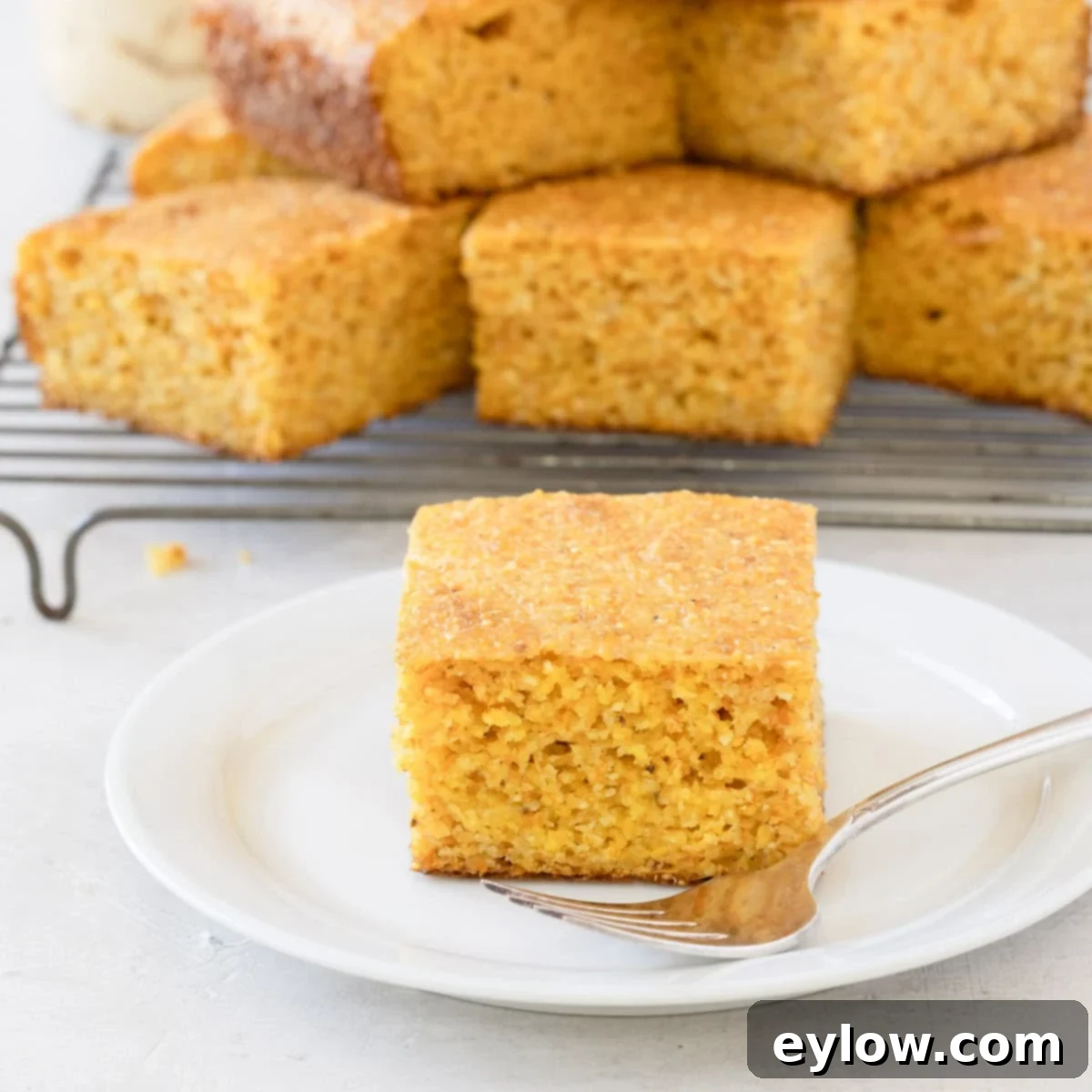The Best Gluten-Free Cornbread Recipe: Moist, Flavorful, and Naturally Flour-Free
After countless test batches, I’ve perfected this gluten-free cornbread recipe to be everything you’ve dreamed of and more. The result is a truly exceptional cornbread: wonderfully moist, bursting with rich corn flavor, and boasting an irresistibly tender crumb. What makes it so special? It’s crafted entirely without wheat flour, making it naturally gluten-free and a delightful treat for everyone, whether you follow a gluten-free diet or not. Forget those dry, crumbly alternatives or bland packaged mixes. This homemade version is incredibly quick and easy, coming together in just one bowl and ready to bake in under 10 minutes, with a total time of about 30 minutes from start to finish. Plus, I’ve included a fantastic dairy-free option so even more people can enjoy this Southern-inspired staple. Prepare yourself for the ultimate homemade cornbread experience!

My journey to creating this easy gluten-free cornbread recipe involved extensive experimentation. I baked batch after batch, meticulously testing different types of cornmeal, exploring various grain blends, comparing sugar to honey as sweeteners, and assessing the impact of milk versus buttermilk. I even played with different oven temperatures and baking pans to achieve the ideal texture and flavor profile. This dedicated testing process led me to what I believe is the best gluten-free cornbread – a rustic, authentic style, distinct from the cake-like versions often found. It truly captures the essence of traditional Southern cornbread, made accessible and delicious for all.
While I’m confident this recipe delivers outstanding results, the ultimate judgment rests with you! I poured my heart into perfecting it, and I genuinely believe it’s a game-changer for anyone seeking a truly delicious gluten-free cornbread. If you decide to bake a batch, please don’t hesitate to share your thoughts. Your feedback helps me continue to refine and share recipes that bring joy to your kitchen.
Why You’ll Adore This Gluten-Free Cornbread Recipe
This isn’t just another cornbread recipe; it’s a meticulously developed masterpiece designed to deliver maximum flavor and satisfaction, especially for those navigating a gluten-free lifestyle. Here’s why this recipe will become a beloved staple in your home:
- Naturally Gluten-Free: The most significant feature is its inherent gluten-free nature. Unlike many recipes that rely on specialized gluten-free flour blends, this cornbread is made exclusively with pure cornmeal. This means you avoid the often gritty texture or complex ingredient lists associated with wheat-free baking, resulting in a naturally tender and authentic cornbread that everyone can enjoy without compromise.
- Honey-Sweetened Goodness: Rather than relying on refined white sugar, this recipe uses honey as its primary sweetener. Honey not only imparts a subtle, natural sweetness but also contributes to the cornbread’s exceptional moistness and a wonderfully nuanced flavor that complements the corn. It’s truly a honey cornbread experience.
- Rich Buttermilk Base (with Dairy-Free Options!): Buttermilk is a secret weapon for tender, flavorful cornbread. Its acidity reacts with baking soda to create a light, airy texture, while its unique tang deepens the overall taste. For those avoiding dairy, I’ve provided a simple and effective dairy-free substitution, ensuring no one misses out on this incredible flavor.
- Unbelievably Moist Texture: Dry cornbread is a culinary disappointment. Through careful ingredient ratios and testing, this recipe guarantees a moist, never-dry texture. Each bite is tender and inviting, perfectly balancing a sturdy structure with a delicate crumb that melts in your mouth.
- Versatile & Perfect for Any Occasion: This cornbread is incredibly versatile. It makes an ideal side dish for a hearty bowl of soup, a comforting chili, or a fresh salad. It’s also sturdy enough to be transformed into a flavorful cornbread dressing for holiday feasts, making it a must-have for Thanksgiving turkeys, Christmas hams, or a simple Sunday roast chicken.
Looking for the perfect pairing? Try this southwestern turkey chili recipe with your fresh-baked cornbread – it’s a match made in heaven!
Essential Gluten-Free Cornbread Ingredients
Crafting the perfect gluten-free cornbread begins with selecting the right ingredients. Each component plays a vital role in achieving that moist texture, bold corn flavor, and beautiful golden hue. Here’s a closer look at what you’ll need and why:
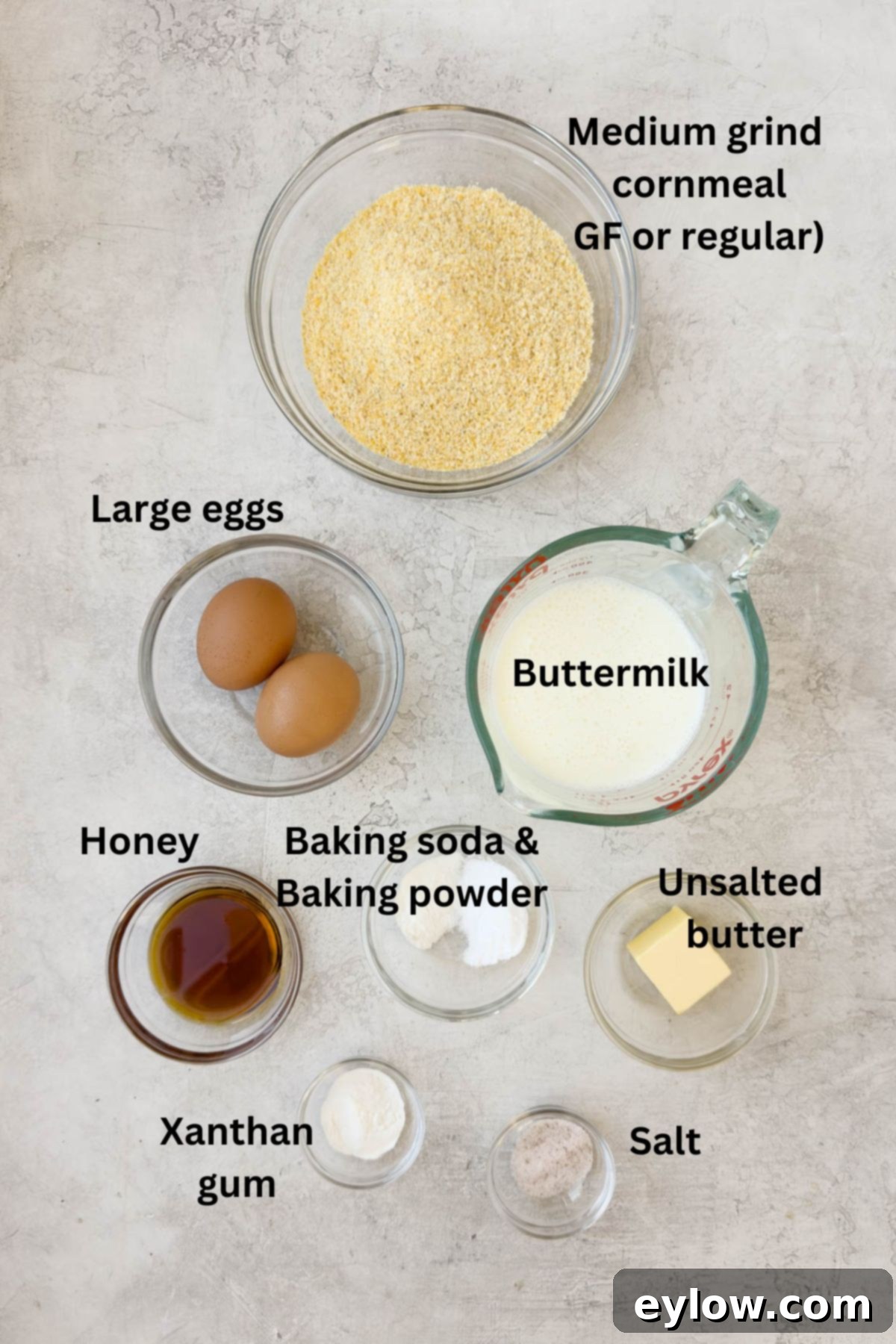
- Gluten-Free Cornmeal: This is the star of our cornbread! Pure cornmeal is inherently gluten-free, derived simply from dried and ground corn. However, for those with gluten sensitivities or Celiac disease, it’s crucial to purchase cornmeal explicitly labeled “certified gluten-free.” This certification ensures there has been no cross-contamination during the processing or packaging, which can sometimes occur with shared equipment. For that classic, appetizing golden color, opt for yellow cornmeal. Absolutely avoid using corn flour, as it has a much finer consistency and behaves entirely differently in baking, leading to a denser, less desirable texture.
- Xanthan Gum: A small but mighty ingredient in gluten-free baking! Since we’re not using wheat flour, which provides gluten for structure, xanthan gum steps in to mimic those binding properties. It helps to provide structure, elasticity, and prevents your cornbread from being too crumbly, ensuring a tender yet cohesive crumb.
- Baking Powder: This leavening agent creates air pockets, contributing to the cornbread’s light and fluffy texture. Always buy aluminum-free baking powder to avoid any metallic aftertaste. Importantly, always check the expiration date on your package; old baking powder loses its potency, and your cornbread won’t rise properly.
- Baking Soda: Working in conjunction with the acidic buttermilk (or its dairy-free substitute), baking soda is another crucial leavening agent. It reacts to produce carbon dioxide, giving the cornbread lift and contributing to its tender crumb.
- Buttermilk: Low-fat buttermilk is preferred for this recipe. Its acidity is essential for activating the baking soda, creating a lighter texture. Beyond its leavening power, buttermilk also contributes a subtle tang and significant moisture, resulting in a richer flavor and preventing a dry outcome. Don’t forget to shake it well before measuring!
- Eggs: Large, fresh, un-cracked eggs provide structure, moisture, and help bind the ingredients together, contributing to the cornbread’s overall stability and richness.
- Butter: I exclusively use and recommend unsalted butter for baking. This allows you to control the exact amount of salt in the recipe, ensuring the perfect balance of flavors. Melted butter adds richness and a delightful tenderness to the cornbread.
- Sweetener (Honey): In this recipe, honey completely replaces white sugar. Using a mild-flavored honey, such as clover, orange blossom, or acacia, is recommended to ensure its sweetness complements the corn flavor without overpowering it. Honey not only sweetens but also adds to the cornbread’s moistness and provides a lovely golden hue.
For precise measurements, please refer to the detailed recipe card provided below.
If you’re looking for delicious soups to serve alongside your warm cornbread, consider this Instant Pot lentil soup, or browse the extensive soup recipes index for a wide variety of comforting options. Cornbread and soup are a classic, cozy combination!
Chef’s Tip: Choosing Your Cornmeal. For this recipe, I find that a medium-grind, stone-ground yellow organic cornmeal from brands like Bob’s Red Mill delivers the best texture and flavor. While Bob’s Red Mill offers many non-GMO products, always check for “certified gluten-free” if you have Celiac disease to avoid cross-contamination. The grind size is important: medium grind provides a pleasant rustic texture, whereas a fine grind can lead to a denser cornbread, and coarse grind might result in a more granular feel. Choose what is best suited for your dietary needs and desired texture!
Substitutions and Variations for Your Gluten-Free Cornbread
This gluten-free cornbread recipe is designed to be adaptable, catering to various dietary needs and taste preferences. Here are some common substitutions and exciting variations you can explore:
- For Dairy-Free Cornbread: Easily transform this into a dairy-free delight! Substitute the buttermilk with an equal amount of unsweetened plant-based milk, such as almond milk or coconut milk (ensure it’s the beverage kind, not canned coconut cream). To replicate the necessary acidity of buttermilk, simply add 1 ½ tablespoons of lemon juice or apple cider vinegar to the plant milk. Stir it gently and let it stand for 5-10 minutes, or until it visibly curdles and becomes slightly lumpy. This crucial step activates the baking soda, ensuring your cornbread rises beautifully.
- Dairy-Free Butter Substitution: If you’re going completely dairy-free, use a high-quality plant-based butter alternative in place of regular butter. Look for solid stick varieties, often labeled “European-style cultured vegan butter,” rather than the softer, tub-style spreads, as they perform better in baking for both flavor and texture. Miyoko’s Kitchen is a good example of a brand that offers excellent plant-based butter.
- For a Sweeter Cornbread: While this recipe is designed to have a balanced, subtly sweet flavor from honey, you can easily adjust the sweetness to your liking. Feel free to add an extra tablespoon or two of honey to the batter for a noticeably sweeter result. You can also experiment with a combination of honey and a small amount of brown sugar for a different depth of sweetness.
- If You Can’t Use Xanthan Gum: If xanthan gum isn’t available or you prefer an alternative, you have a couple of options. You can swap it for an equal amount of guar gum, which also acts as a binder and thickener in gluten-free baking. Alternatively, you can use twice as much psyllium husk (be sure to use the whole husks, not the powdered form) to achieve a similar binding effect.
Chef’s Note: What is Xanthan Gum? Xanthan gum is a natural polysaccharide often used in gluten-free baking. Its primary role is to act as a binder and provide structure, helping to mimic the elasticity and texture that gluten provides in wheat-based baked goods. Even a small amount is highly effective. It adds volume, improves crumb structure, and prevents baked goods from becoming overly crumbly. You can usually find it in the baking or specialty food aisle of most grocery stores. As mentioned, guar gum is a common alternative; it’s generally less expensive and widely available, and while I haven’t specifically tested this cornbread recipe with guar gum, it is a very common substitute for xanthan gum and should yield comparable results.
Step-by-Step Gluten-Free Cornbread Instructions
Making this moist and flavorful gluten-free cornbread is straightforward and quick, perfect for a weeknight dinner or a weekend brunch. Follow these simple steps for a perfect batch every time:
Tool Note: For optimal results, I highly recommend baking this gluten-free cornbread in a light-colored metal square pan, typically an 8×8 inch. Darker non-stick pans or cast iron skillets can sometimes cause the bottom to brown too quickly or even burn before the center is fully cooked. To ensure easy removal and protect the bottom of your cornbread, either line the bottom of the pan with a square of parchment paper or thoroughly coat it with cooking spray. I’ve successfully used both methods.
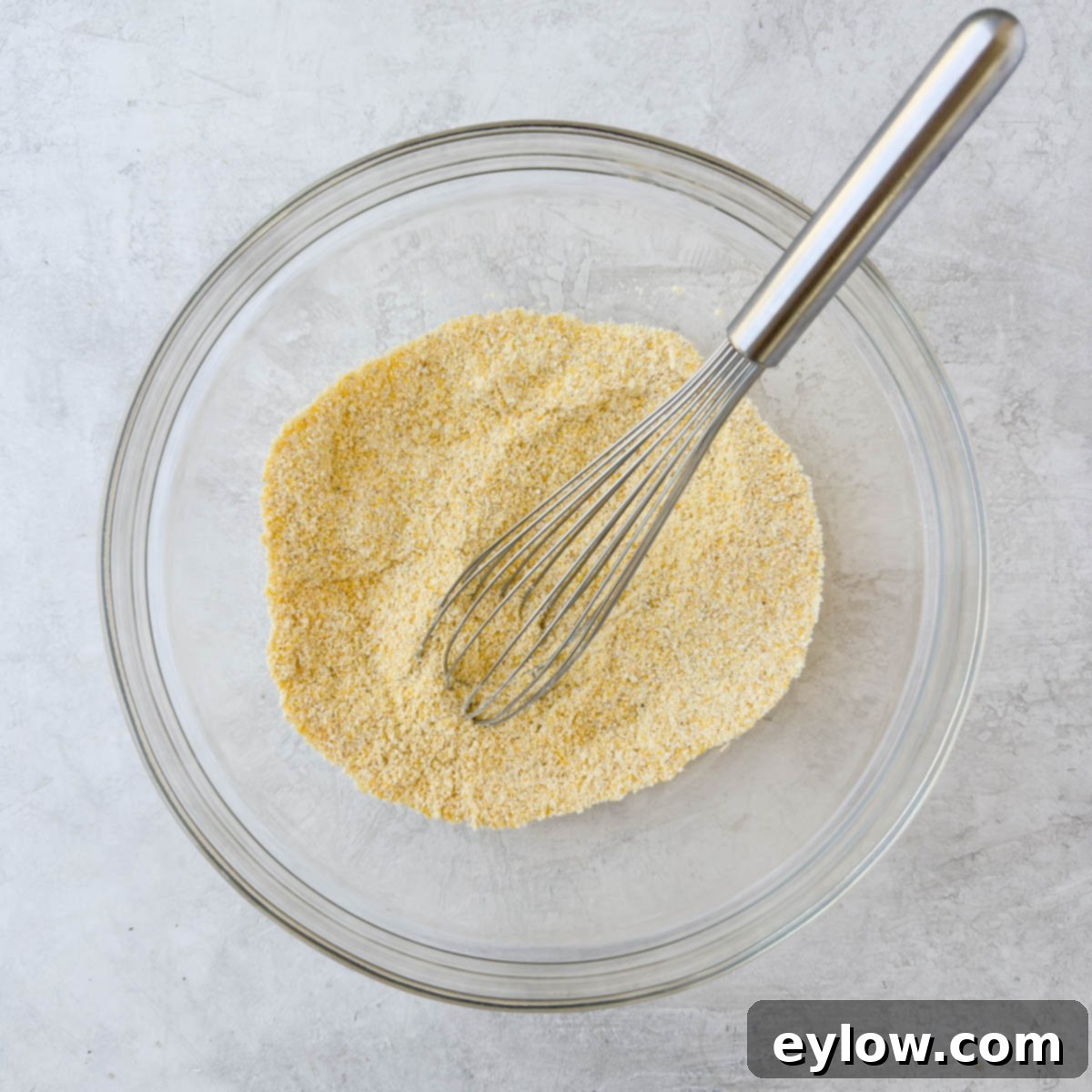
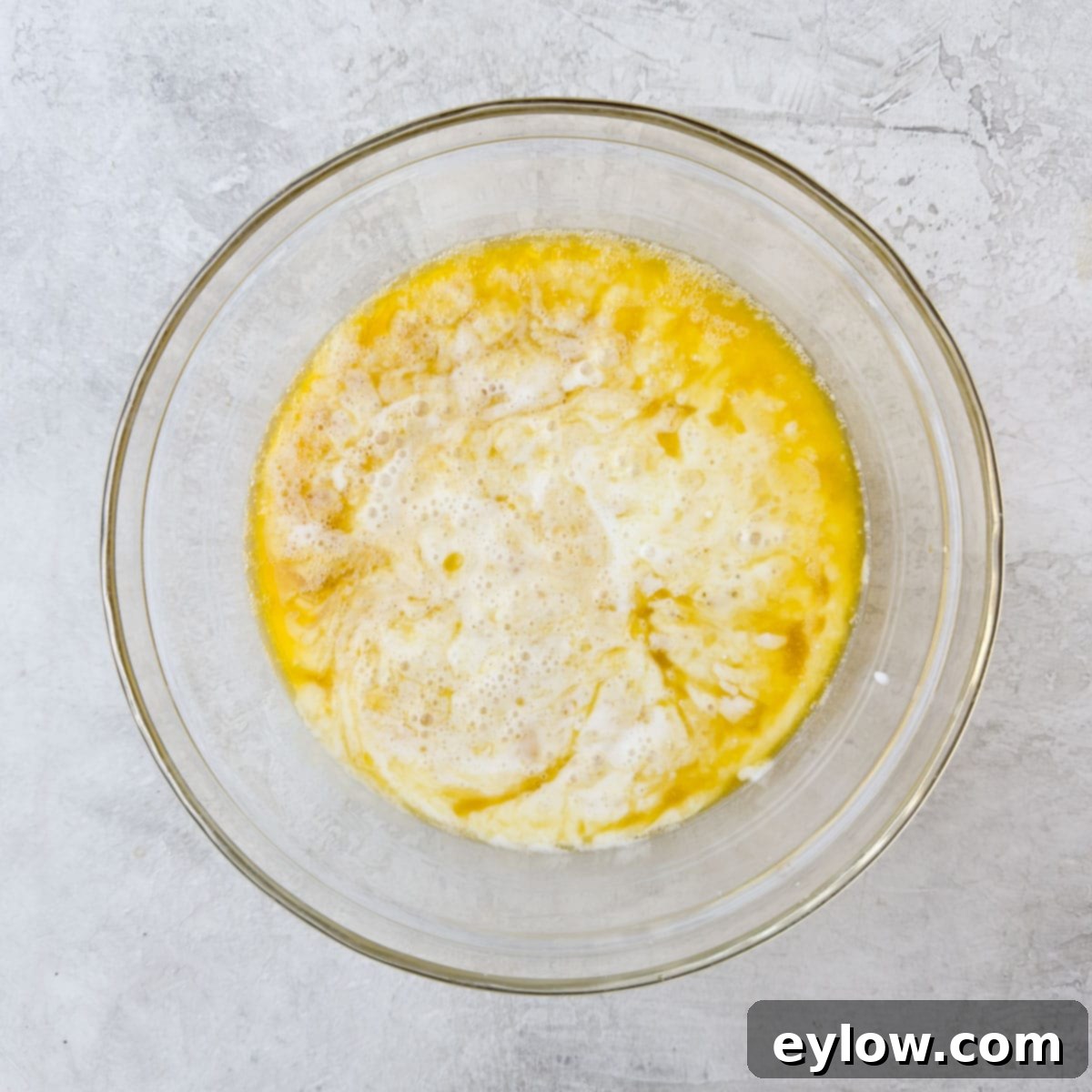
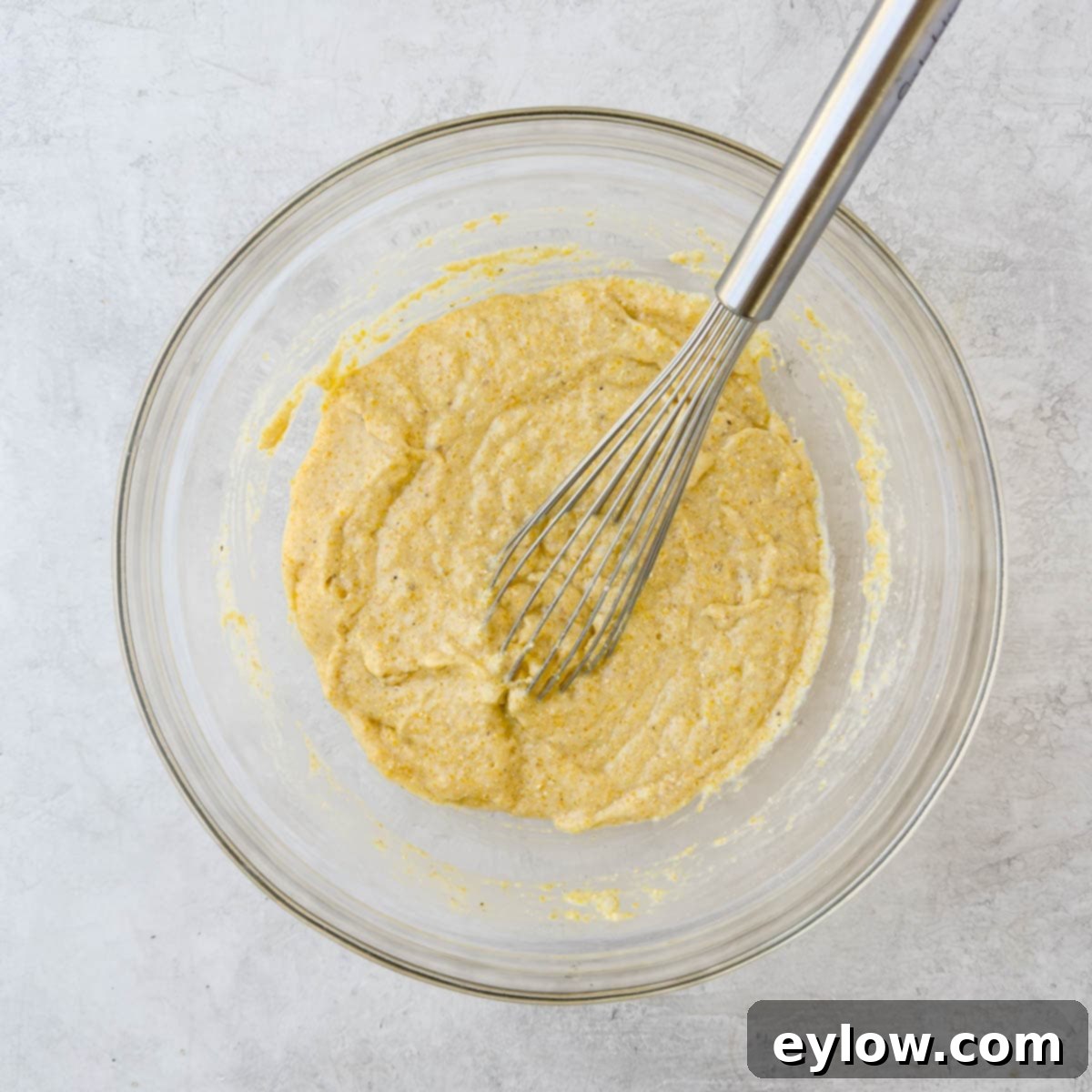
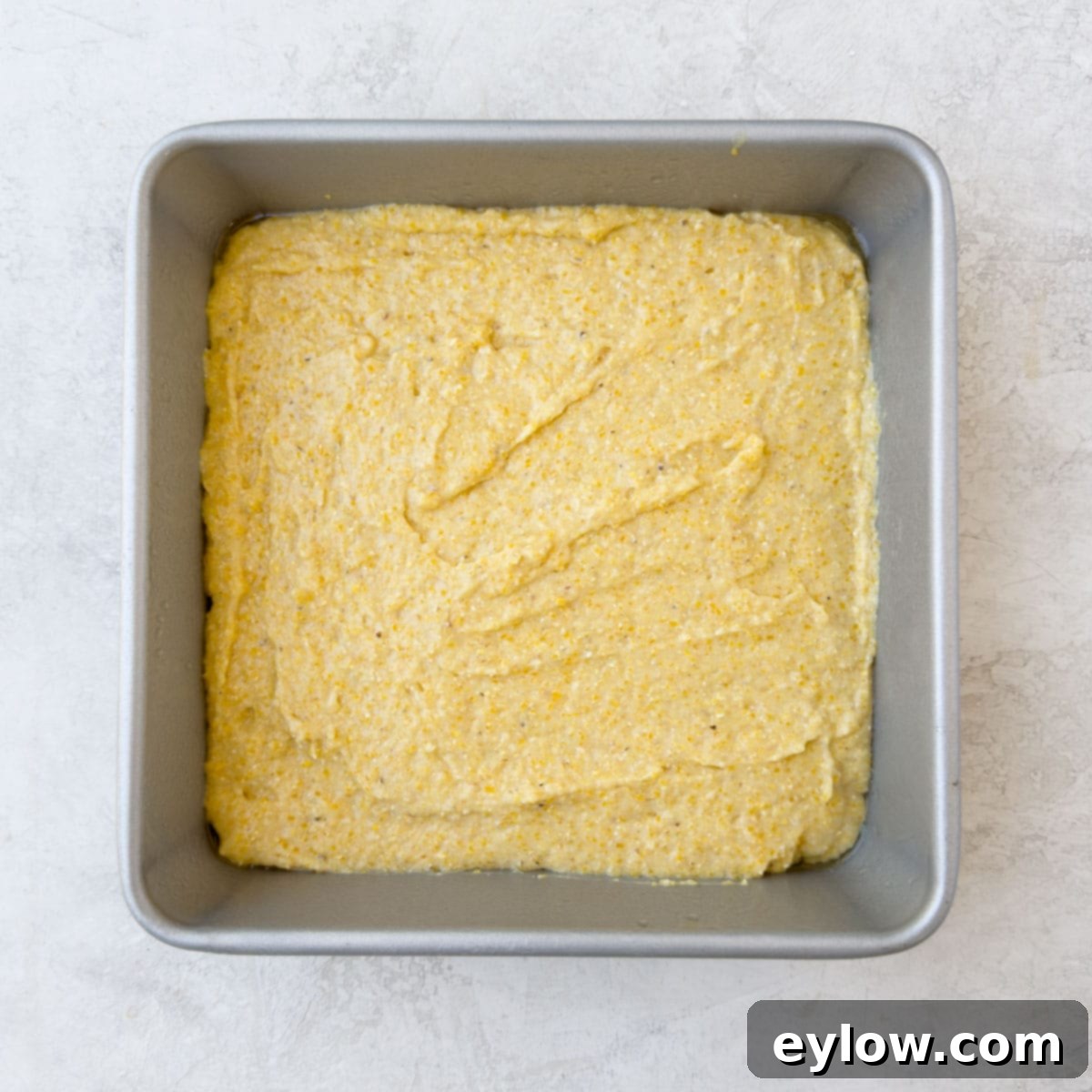

Delicious Serving Suggestions for Your Gluten-Free Cornbread
This moist gluten-free cornbread is incredibly versatile and pairs wonderfully with a variety of dishes, elevating any meal from simple to spectacular. Here are some of my favorite ways to enjoy it:
- Classic Comfort Food: Serve generous squares alongside a steaming bowl of hearty soup, a robust chili, or a refreshing salad. Its rustic texture and rich flavor provide the perfect counterpoint to savory main courses.
- Holiday Feasts: Don’t limit cornbread to just a side! It’s an indispensable component for traditional holiday meals. Transform it into an incredible gluten-free cornbread dressing (or stuffing) for your Thanksgiving turkey, Christmas ham, or a classic roast chicken throughout the year. Its tender crumb absorbs flavors beautifully.
- Breakfast or Snack: Enjoy a warm piece with your morning coffee or tea. It’s also a satisfying and wholesome snack any time of day.
- With Sweet Toppings: While delicious on its own, a touch of sweetness can truly make it sing. Classic accompaniments include a drizzle of pure maple syrup, a dollop of fruit jam, or a spread of honey butter.
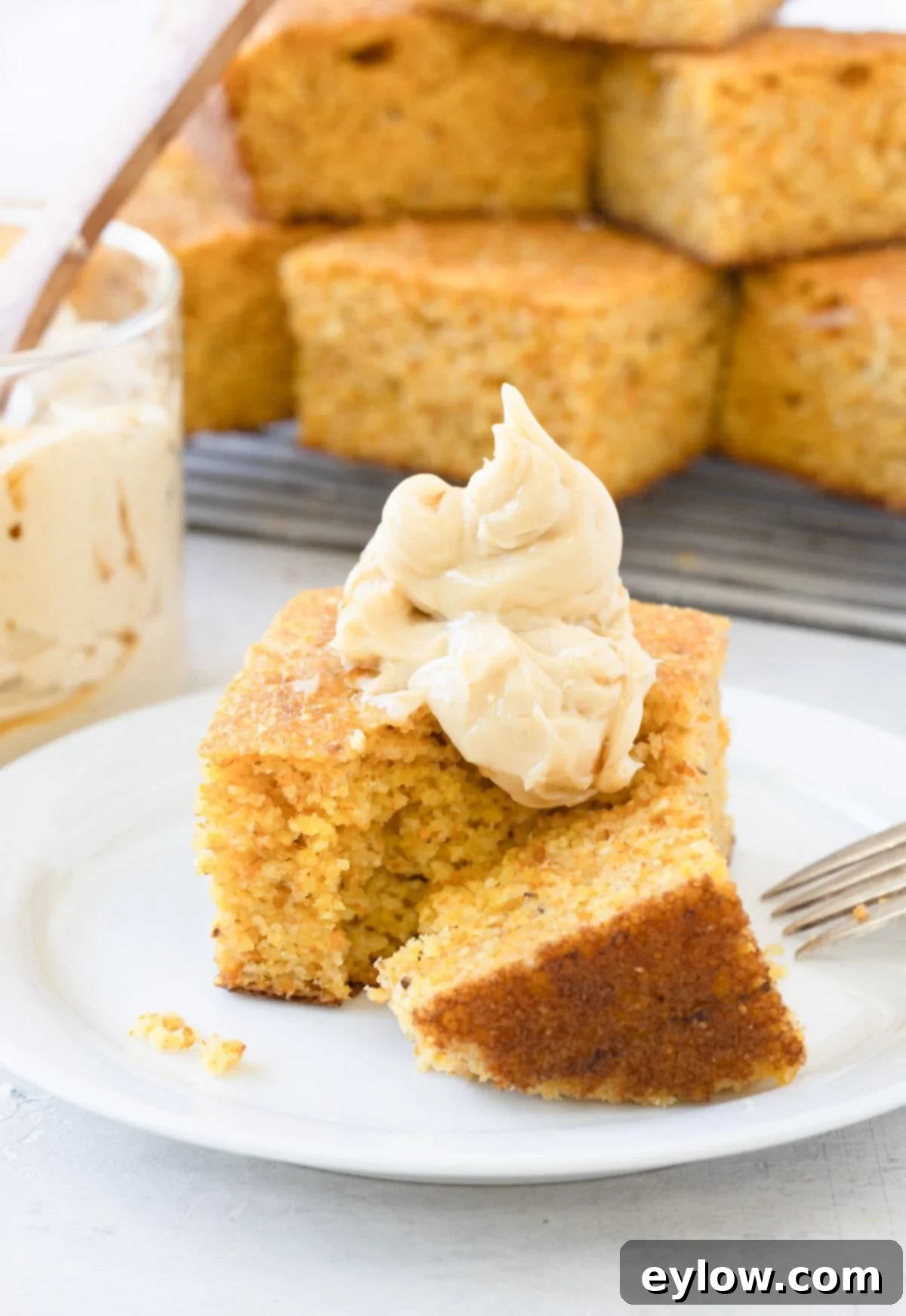
Homemade Maple Butter: The Perfect Companion
To truly elevate your cornbread experience, you must try it with homemade maple butter or honey butter. It’s incredibly simple to prepare and adds a layer of luxurious sweetness and richness. All you need are two sticks of softened unsalted butter and a few tablespoons of pure maple syrup (or honey). Just whip them together until light and fluffy. This creamy, sweet topping melts beautifully into the warm cornbread, creating an unforgettable bite. You can find a detailed recipe for homemade maple butter here.
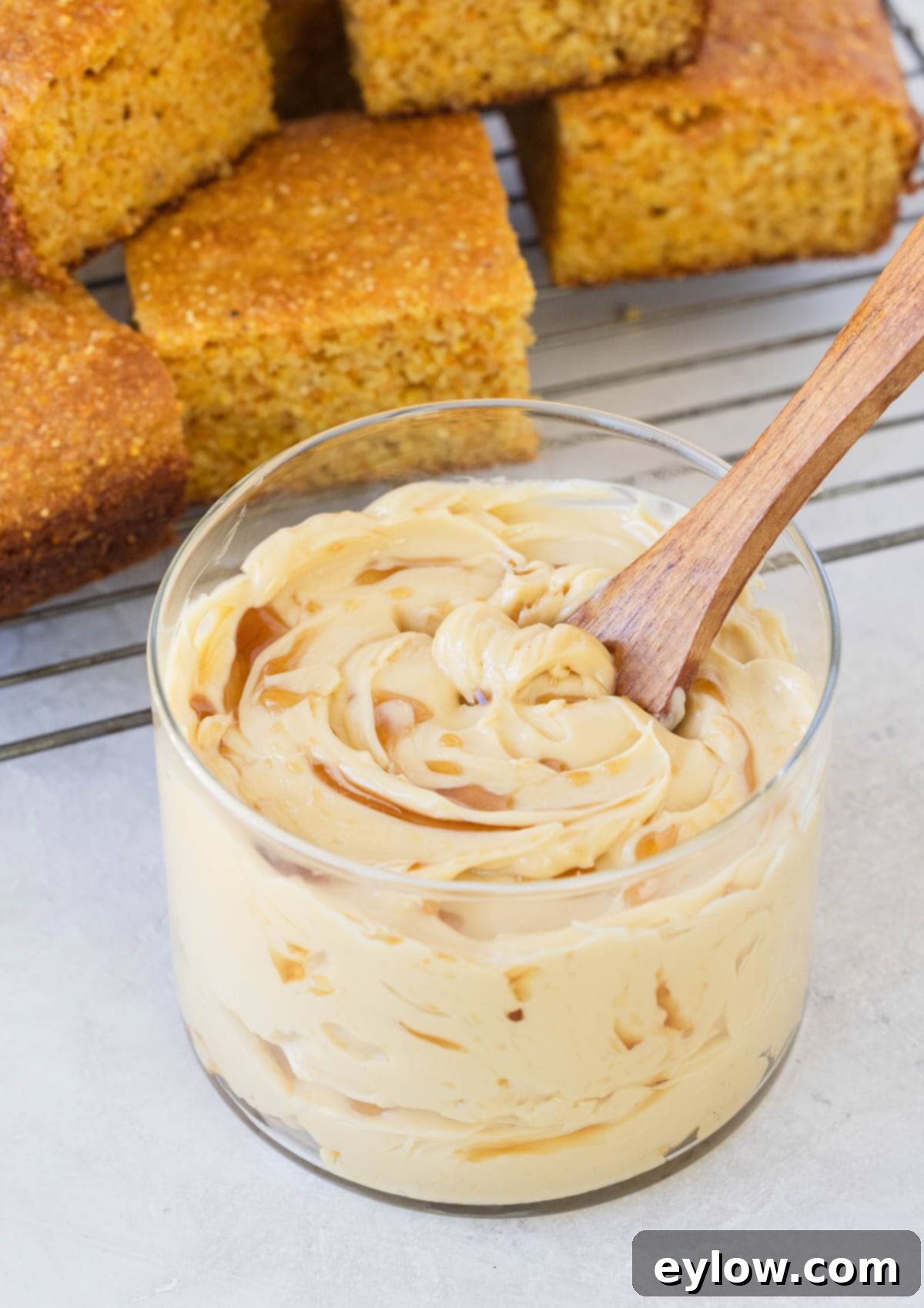
Storing Your Delicious Cornbread
Proper storage is key to enjoying your homemade gluten-free cornbread for as long as possible. Leftover cornbread will stay fresh on the counter for up to 3 days when tightly wrapped in plastic wrap or aluminum foil. For extended freshness, store it in an airtight container in the refrigerator for up to a week. Cornbread also freezes exceptionally well for about 3 months. To freeze, wrap individual pieces or the whole loaf tightly in plastic wrap, then an additional layer of aluminum foil, and finally place it in a freezer-safe zip-top bag. Always remember to label and date your frozen items so you know exactly what you have.
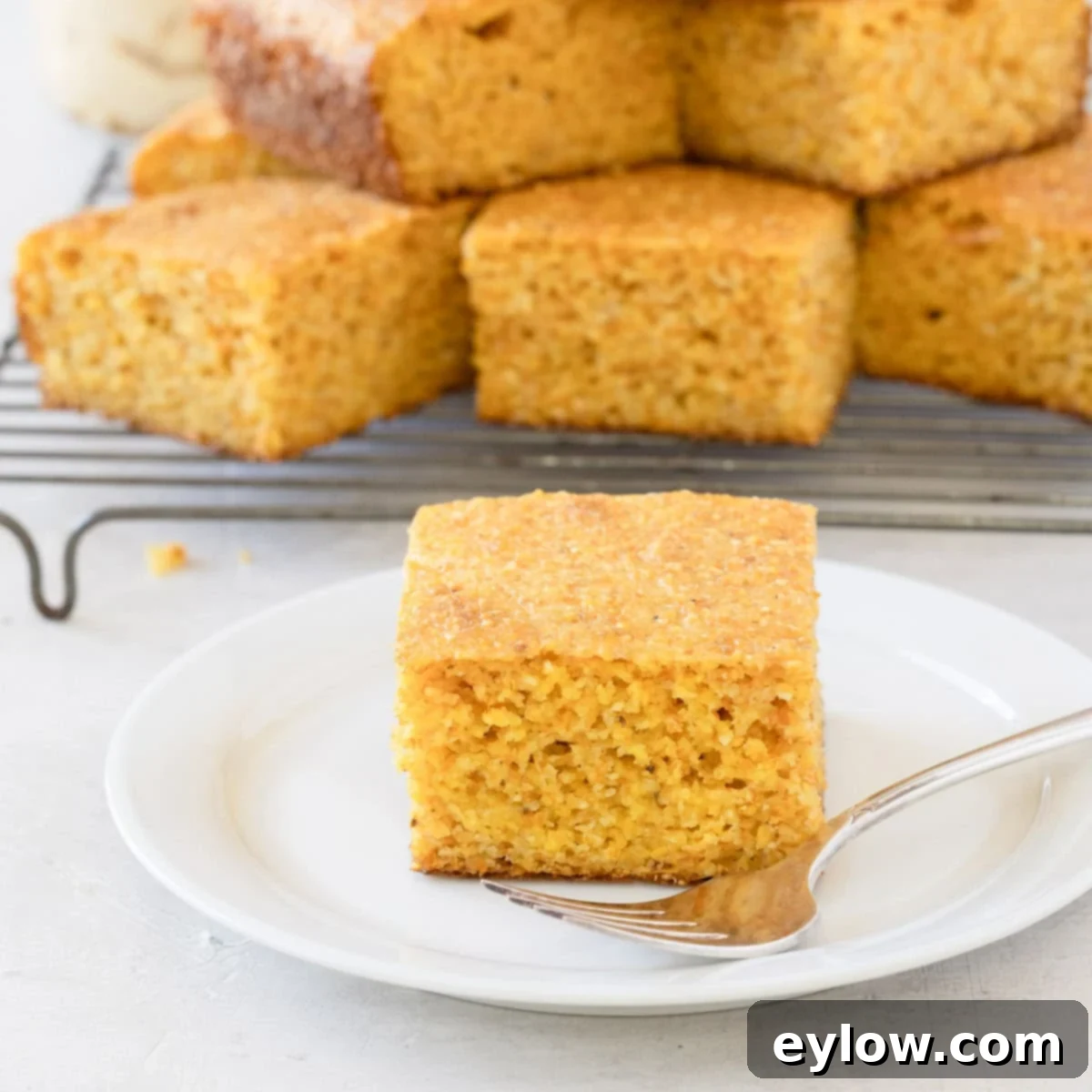
Recipe FAQs: Your Gluten-Free Cornbread Questions Answered
Here are answers to some common questions about making and enjoying this gluten-free cornbread:
Yes, absolutely! Cornmeal is a grain derived from ground corn, which is naturally gluten-free. However, if you or someone you’re baking for has Celiac disease or a severe gluten sensitivity, it is vital to purchase cornmeal that is specifically certified and labeled “gluten-free.” This label guarantees that the product has been processed and packaged in facilities free from cross-contamination with wheat or other gluten-containing grains.
While both cornmeal and polenta come from dried ground corn, they are not entirely identical. Cornmeal, particularly for American baking, is typically more finely ground. Polenta, on the other hand, is generally a bit coarser in grind (similar to grits). Historically, they also originated from different types of corn: traditional American Southern grits or cornmeal were made from dent corn, while Italian polenta was derived from flint corn. Today, these terms are often used interchangeably, and you might find them in similar grind sizes, but subtle differences in texture and traditional use persist. For cornbread, a medium-grind cornmeal is usually best.
For this recipe, and generally for making excellent cornbread, a medium-grind, stone-ground cornmeal is highly recommended. The medium grind provides a wonderful, slightly rustic texture that is neither too dense nor too coarse. Using a very fine ground cornmeal can result in a denser, almost cake-like cornbread, which isn’t the desired texture for this “almost Southern” style. Conversely, a very coarse grind might yield a more granular or even gritty texture. Sticking to what the recipe calls for – a medium grind – is the safest bet for achieving consistently delicious results.
Authentic Southern cornbread is characterized by several key elements. Firstly, it typically contains no, or very little, wheat flour; true Southern recipes are often made entirely with cornmeal, just like this one. Secondly, it tends to have little to no added sugar, allowing the natural sweetness of the corn to shine through – though some modern Southern recipes might include a touch of sweetness, honey is a lovely compromise here. Thirdly, it’s traditionally baked in a well-seasoned cast iron pan or skillet, which creates an incredibly golden, crispy crust. While butter is a common and delicious fat, some traditional Southern cooks might use lard or bacon fat for added depth of flavor. I personally prefer the rich taste that butter imparts.
Explore More Delicious Gluten-Free Baking Recipes
If you love to bake and appreciate delicious gluten-free options, you’ll adore these easy quick breads and muffin recipes. They are perfect for breakfast, snacks, or a delightful treat:
- Gluten-Free Carrot Cake Muffins (dairy-free)
- Easy Gluten-Free Pumpkin Bread Recipe
- Easy Gluten-Free Irish Soda Bread
- Gluten Free Strawberry Muffins
⭐️ Did You Make This Recipe?
If you give this naturally gluten-free cornbread recipe a try, I’d absolutely love to hear from you! Please take a moment to leave a comment below and let me know how you liked it. Your feedback is invaluable, and if you truly loved it, a 5-star rating would be greatly appreciated! Ratings and comments genuinely help other readers discover and enjoy these recipes, and I always look forward to hearing about your culinary creations.
📖 Recipe
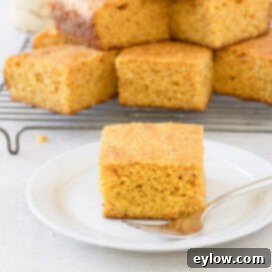
Gluten-free Cornbread (no flour)
Sally Cameron
Pin Recipe
Equipment
-
1 8×8 light colored metal baking pan
-
Parchment paper
Ingredients
Dry ingredients
- 1 ½ cups gluten-free cornmeal 8 ounces
- 1 ½ teaspoons baking powder 6 grams
- 1 teaspoon xanthan gum 4 grams
- ¾ teaspoon baking soda 2 grams
- ¾ teaspoon salt 5 grams
Wet ingredients
- 1 ¼ cups low fat buttermilk remember to shake it!
- 2 large eggs beaten
- 2 tablespoons unsalted butter melted and cooled slightly
- 2 tablespoons honey
Instructions
Mix Dry Ingredients
-
Gather all your ingredients and pre-heat the oven to 375 degrees F (190 degrees C). In a large mixing bowl, combine the gluten-free cornmeal, xanthan gum, baking powder, baking soda, and salt. Whisk these dry ingredients together thoroughly for about 30 seconds to ensure they are well incorporated and evenly distributed.
Mix Wet Ingredients & Combine
-
In a separate large measuring cup or bowl, whisk together the low-fat buttermilk (or your prepared dairy-free substitution) until smooth. Then add the beaten eggs, melted and slightly cooled unsalted butter, and honey. Whisk until all these wet ingredients are fully combined and the mixture is uniform. Pour the wet mixture into the bowl containing the dry ingredients. Gently whisk until the batter is just smooth, being careful not to overmix. A few small lumps are perfectly fine.
Prepare Pan, Bake, and Cool
-
Prepare an 8″x8″ light-colored square baking pan. Cut a square of parchment paper to fit snugly into the bottom of the pan, then spray the entire pan (including the parchment) with nonstick cooking spray. Pour the cornbread batter evenly into the prepared pan. Bake on the center rack of your preheated oven for approximately 20-25 minutes (baking times can vary slightly, especially with convection ovens, which might bake a little faster). The cornbread is done when the top is golden brown, feels firm to the touch, and a toothpick or cake tester inserted into the center comes out clean or with only moist crumbs attached. You’ll also notice the cornbread pulling away slightly from the sides of the pan, and your kitchen will be filled with a delightful, sweet corn aroma. Once baked, remove from the oven and allow it to cool in the pan for a few minutes before carefully inverting it onto a wire rack to cool completely.
-
To serve, cut the cornbread into squares. If you plan to use this cornbread for a dressing or stuffing recipe, refer to our specific post on cornbread stuffing for instructions on how to properly cut and dry the cornbread for that purpose.
Notes
To substitute xanthan gum, you can use the same amount of guar gum, which functions similarly as a binder in gluten-free baking. Alternatively, you can use twice as much psyllium husk (ensure you’re using the whole husks, not the powdered form) for a comparable binding effect.
